The product difference between two pairs (a, b) and (c, d) is defined as (a * b) - (c * d).
- For example, the product difference between
(5, 6)and(2, 7)is(5 * 6) - (2 * 7) = 16.
Given an integer array nums, choose four distinct indices w, x, y, and z such that the product difference between pairs (nums[w], nums[x]) and (nums[y], nums[z]) is maximized.
Return the maximum such product difference.
Example 1:
Input: nums = [5,6,2,7,4] Output: 34 Explanation: We can choose indices 1 and 3 for the first pair (6, 7) and indices 2 and 4 for the second pair (2, 4). The product difference is (6 * 7) - (2 * 4) = 34.
Example 2:
Input: nums = [4,2,5,9,7,4,8] Output: 64 Explanation: We can choose indices 3 and 6 for the first pair (9, 8) and indices 1 and 5 for the second pair (2, 4). The product difference is (9 * 8) - (2 * 4) = 64.
Constraints:
4 <= nums.length <= 1041 <= nums[i] <= 104
Solution: Greedy
Since all the numbers are positive, we just need to find the largest two numbers as the first pair and smallest two numbers are the second pair.
Time complexity: O(nlogn) / sorting, O(n) / finding min/max elements.
Space complexity: O(1)
C++
|
1 2 3 4 5 6 7 8 9 |
// Author: Huahua class Solution { public: int maxProductDifference(vector<int>& nums) { const int n = nums.size(); sort(begin(nums), end(nums)); return nums[n - 1] * nums[n - 2] - nums[0] * nums[1]; } }; |
Python3
|
1 2 3 4 5 |
# Author: Huahua class Solution: def maxProductDifference(self, nums: List[int]) -> int: nums.sort() return nums[-1] * nums[-2] - nums[0] * nums[1] |

